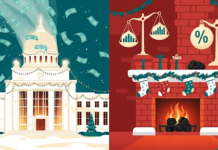Americans are experiencing a welcome relief at the gas pump this Thanksgiving, with gasoline prices showing a notable decline compared to earlier in the year.
This much-needed breather can be attributed to several factors, including a decrease in global crude oil prices, ample oil supplies, and reduced demand as the summer driving season comes to a close.
These factors have combined to ease the financial burden on consumers as they hit the road to celebrate the holiday season, providing some relief from the elevated fuel costs seen in recent months.
Falling Crude Oil Prices
The price of Crude Oil Futures has dropped 20.39% from a high of $95.03 on September 28 down to today’s price $75.62
Falling crude oil prices have a direct and significant impact on gas prices at the pump. Since gasoline is derived from crude oil, a decrease in crude oil prices typically leads to lower production costs for gasoline.
Refineries can pass these cost savings along to consumers by reducing the price of gasoline. As a result, when crude oil prices fall, it often translates into lower gas prices at the pump, providing relief to consumers and potentially stimulating economic activity by reducing transportation costs for businesses and households.
However, it’s important to note that other factors, such as refining costs, taxes, and supply and demand dynamics, can also influence gas prices and may partially offset the impact of falling crude oil prices.
What’s Happening at the Gas Pump?
In a report from CNBC, the national average price for a gallon of gasoline has fallen to $3.25 which is the lowest Thanksgiving price since 2020.
In the CNBC report, gasoline demand fell to 8.9 million barrels per day in the week ending Nov. 10, compared to 9.5 million bpd in the week prior, according to the U.S. Energy Information Agency.
At the same time, domestic crude inventories rose by 3.6 million barrels to a total of 439.4 million barrels, outstripping expectations. U.S. crude production continues at a record clip of 13.2 million bpd.
What’s Happening to Energy Stocks?
Many of the key energy stocks, like Exxon Mobil (XOM) and Occidental Petroleum (OXY) have traveled on the same downward path as Crude Oil.
For the purpose of this discussion, I have selected the SPDR Select Sector Fund – Energy Select Sector (XLE) to take a sector-wide view of energy price trends.
As you can see, this chart is very similar to the drop in Crude Oil prices since September 28.
From a technical standpoint, XLE has broken officially below the 200 Simple Moving Average (SMA) shown in red. When stocks travel below the 200 SMA, they are usually considered in Bear Market territory.
On Wednesday, November 22, XLE rallied back up to the 200 SMA. The key question is… will XLE break through the 200 SMA on Black Friday into Bull Market territory, or will the 200 SMA hold up as resistance, and keep the ETF in bear market territory. It’s time to stay patient and let the market show its hand.
Chart Observation: The 3EMA/8EMA Crossover
Renowned trading guru Stephen Bigalow, who recently passed away used the 8 Exponential Moving Average (EMA) which he called the “T-Line” to analyze stocks.
Notice how price has a tendency to hug the 8 EMA, shown in purple.
- When price travels above the 8EMA, the stock is usually in an uptrend.
- When price falls below the 8 EMA, the stock is usually in a downtrend.
Next, we plot the 3 EMA. Price also hugs the 3 EMA, but this EMA moves faster.
- When the 3EMA crosses above the 8EMA it usually signals a price reversal to the upside.
- When the 3 EMA crosses below the 8EMA, it usually signals a price reversal to the downside.
If you use this analysis, in conjunction with other price momentum indicators, like the RSI, Williams%R or Stochastics, it is possible to gain an edge in your trading.
In the example shown above, an XLE CALL option (dated out 1 month) on the bullish crossover could have returned a gain of over 50% in just two days on the $2.00 bullish price move. The bearish crossover would have yielded a 35% gain in just 2 days,according to Optionsprofitcalculator.com.
Conclusion
With the holiday season now in full swing, the falling gasoline prices come as a welcome reason for gratitude. With the national average for gasoline prices at its lowest point since Thanksgiving 2020, and states like Texas seeing prices as low as $2.77 per gallon, consumers have an extra reason to be thankful this holiday season.
Lower fuel costs can ease the financial burden on travelers, enabling them to spend more quality time with loved ones and enjoy the festivities without the strain of high transportation expenses.
It’s a reminder that even in challenging times, there are moments of relief and reasons to give thanks.

























